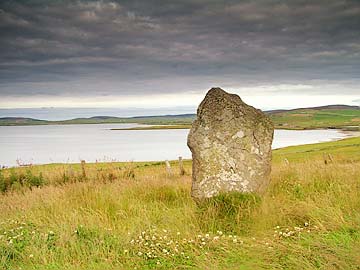
 |
 |
| Home |
| About Orkney |
| History |
| Tradition |
| Folklore |
| Placenames |
| Images |
| Downloads |
| About the Site |
| Contact |
| Links |
| Search Site |
| Awards |
| Orkney's Standing Stones | |
|
The Deepdale Stone, Stromness Although Orkney is home to a number of well-known standing-stones, such as the Ring of Brodgar, it also has its fair share of lesser-known monoliths. These stones, scattered across the islands, are often ignored because they are inaccessible, unnoticed, or, quite simply, don't look as impressive as their larger relatives. Barely noticeable from the main Kirkwall to Stromness road - unless you know when, and where, to look - the Deepdale stone stands approximately two metres (7 feet) high. Located on private ground, it pokes out from a crest of high ground on the western side of the current road, directly opposite the Stenness loch. The Deepdale megalith once had a companion, but no visible trace of this stone survives today. This second stone - which, it is believed, was slightly taller than its companion - was loosened after years of ploughing. It was removed sometime between the 1940s and the 1970s.
The two standing stones' position, on the western horizon, led to the theory that the Deepdale stones may have been aligned, or were outliers, to the Ring of Brodgar, and connected to the setting sun in much the same way as the Barnhouse stone is to the chamber of Maeshowe. However, the distance from Brodgar means that the Deepdale stones would have been very difficult to see with the naked eye. As such it is hard to see how they could have been connected with whatever ceremonies took place within the stone circle. Instead, the two megaliths may have had some connection with the nearby Unstan Cairn. The surviving stone looks down on the headland on which the cairn stands, its face turned towards the structure. It is also possible that the Deepdale Stones were related to the nearby Neolithic site at Howe - now destroyed. Again, however, this is debatable. In the Neolithic only one of the pair would have been visible, peeking over the crest of the hill facing Howe. |
|
 The Deepdale Stone is a fine example of this.
The Deepdale Stone is a fine example of this. Subsequent excavation located the socket hole of the lost stone, along with its surviving stump.
Subsequent excavation located the socket hole of the lost stone, along with its surviving stump.